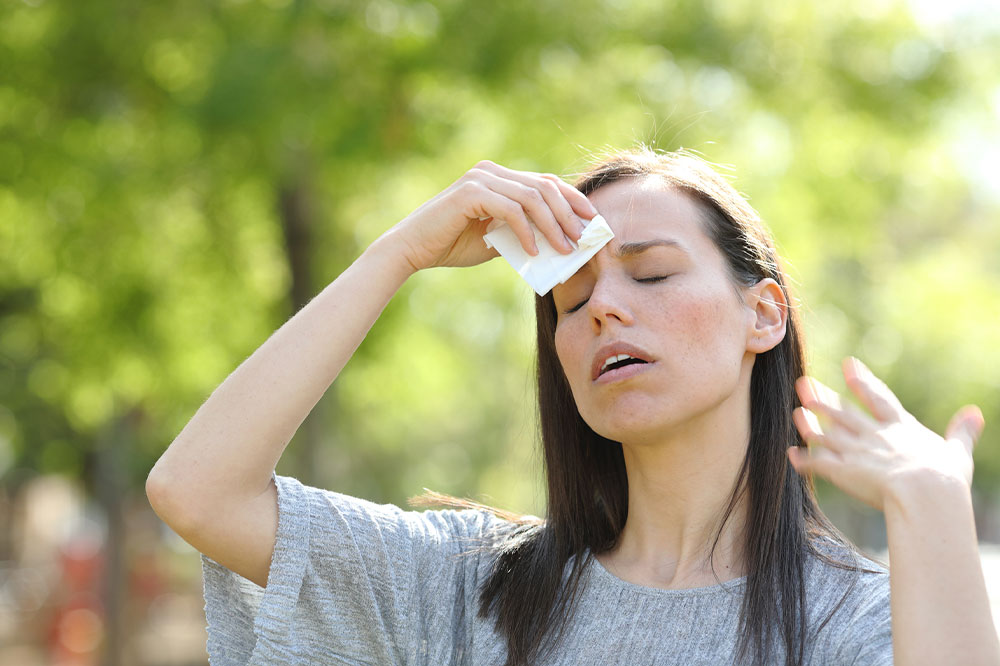6 must-know causes of excessive sweating

Hyperhidrosis, also known as excessive sweating, is a condition where an individual sweats excessively, not necessarily due to heat or exercise. The sweating may be so severe that it drips through clothes, becoming a source of embarrassment. Thankfully, several treatments help reduce sweating and other symptoms, and surgical interventions are also available for severe cases. But it is necessary to know the reason behind it. Below are a few causes of hyperhidrosis or excessive sweating:
Pregnancy
A primary cause of hyperhidrosis is pregnancy. During pregnancy, blood flow increases throughout the body, making women feel warmer and causing excessive sweating. Hormones also tend to fluctuate significantly during gestation, which is a trigger for perspiration. It is more common in the first and third trimesters and can also occur postpartum or after delivery when hormones begin to settle down.
Menopause
Menopause is another reason why a woman’s hormones fluctuate. Hot flashes are the most familiar symptom during this time, caused due to ever-changing levels of estrogen in the body. The fluctuation of this hormone suddenly causes the individual to feel warm and sweat excessively. Nighttime sweats are pretty common in the perimenopausal period. Eating non-spicy food, sitting under a fan, or dressing in light layers help reduce the discomfort associated with extreme sweating caused by menopause.
Hyperthyroidism
It is another hormone-linked cause of hyperhidrosis. Hyperthyroidism is a health condition characterized by an imbalance in thyroxine levels, a hormone that regulates metabolism, body temperature, and heart rate. Besides excessive body sweat, hyperthyroidism presents symptoms like heart palpitations, heat intolerance, tremors, fatigue, and changes in bowel habits or menstrual patterns. Women are more at risk of hyperthyroidism, but it is treatable.
Diabetes
Diabetes mellitus affects the body’s metabolism of sugar. The health condition usually results from inadequate insulin production or the body’s intolerance to insulin. Low blood sugar in diabetes patients can cause a fight or flight response that causes sweating. Prolonged low sugar can also affect the nerves, especially those controlling sweat glands. It can result in episodes of excessive or abnormally low sweating. Diabetics can manage excessive sweating by controlling their blood sugar levels.
Heart attack
A heart attack occurs when there is an obstruction of blood to the heart, and sudden excessive sweating can be an indicator. Heart attacks provoke the sympathetic nervous system and cause a fight or flight response that usually results in hot flashes and sweating. These are often the first signs that make an individual ask for help, along with sudden shortness of breath and pain in the arm, neck, shoulder, chest, or back. Squeezing, tightening, or high-pressure sensations in the chest are other signs. Generally, one can cure this type of hyperhidrosis by treating a heart attack.
Infections and injury
Some infections can cause hyperhidrosis. These include tuberculosis, bone infections like osteomyelitis, abscesses, or HIV. Lymphoma and other malignant tumors can also trigger excessive body sweats. Further, spinal cord injuries cause excessive sweating due to damage to the nerves that control normal sweating in emergencies. Less severe infections could similarly cause excess sweating since the immune system tends to work better at a higher temperature. This is why one gets a fever when suffering from an infection.
How to identify hyperhidrosis?
People sweat when they exercise, expend extra effort, in hot environments, or when anxious or under stress. They naturally sweat all over the body in these situations. This sweating is normal and is no cause for worry. Hyperhidrosis, on the other hand, induces excessive sweating from one region more than others. And sweat release is usually symmetric on both sides of the body. It could be the arms, feet, or face. Such excessive sweating episodes may occur more than once a week.
One should consult a doctor if their sweating pattern affects their daily routine, causes emotional distress, or they sweat profusely at night for no apparent reason. It could be serious if a person suddenly begins sweating more than usual or if sweating is accompanied by lightheadedness, chest pain, or nausea.
Doctors classify hyperhidrosis into two types: primary focal and secondary. Primary focal hyperhidrosis is the most classic form that usually appears in childhood and has no apparent reason. The sweat glands become overactive, especially when nervous or stressed. It is more common during the day and affects the hands and feet. The condition is genetic in most cases and tends to run in families. Secondary hyperhidrosis, by contrast, is when the excess sweating is induced by an underlying health condition or is a side effect of treatment. The sweat is released at various places of the body simultaneously.
How is the condition treated?
There are several treatments for this health condition, but the first recommended method is to use an antiperspirant deodorant. These are easily available at most treatment centers and even supermarkets. Most antiperspirant deodorants contain aluminum-based compounds that temporarily block sweat pores and prevent the amount of sweat produced for around 24 hours. The treatment is available in two strengths: regular and clinical. The latter is more powerful. While antiperspirant deodorants may not reduce odor as regular deodorants, individuals suffering from excessive body sweats benefit from them.






